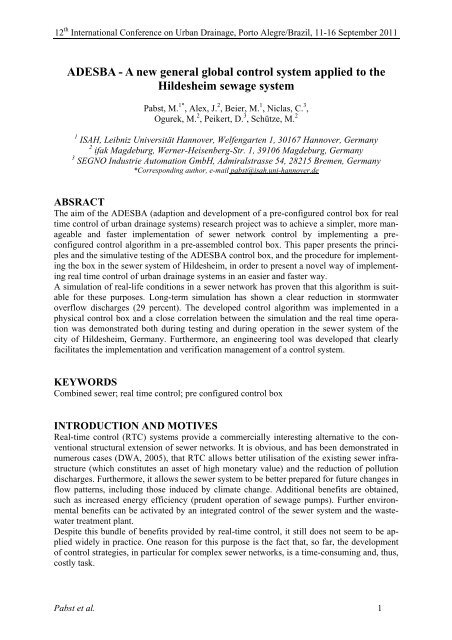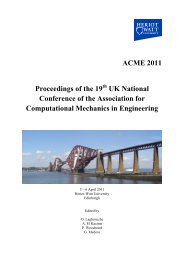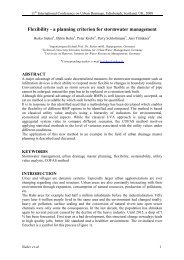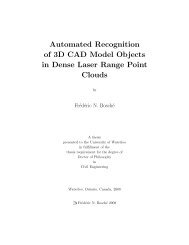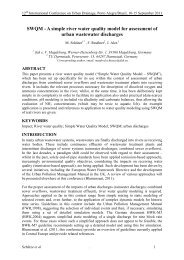ADESBA - A new general global control system applied to the ...
ADESBA - A new general global control system applied to the ...
ADESBA - A new general global control system applied to the ...
You also want an ePaper? Increase the reach of your titles
YUMPU automatically turns print PDFs into web optimized ePapers that Google loves.
12 th International Conference on Urban Drainage, Por<strong>to</strong> Alegre/Brazil, 11-16 September 2011<br />
<strong>ADESBA</strong> - A <strong>new</strong> <strong>general</strong> <strong>global</strong> <strong>control</strong> <strong>system</strong> <strong>applied</strong> <strong>to</strong> <strong>the</strong><br />
Hildesheim sewage <strong>system</strong><br />
Pabst, M. 1* , Alex, J. 2 , Beier, M. 1 , Niclas, C. 3 ,<br />
Ogurek, M. 2 , Peikert, D. 3 , Schütze, M. 2<br />
1 ISAH, Leibniz Universität Hannover, Welfengarten 1, 30167 Hannover, Germany<br />
2 ifak Magdeburg, Werner-Heisenberg-Str. 1, 39106 Magdeburg, Germany<br />
3 SEGNO Industrie Au<strong>to</strong>mation GmbH, Admiralstrasse 54, 28215 Bremen, Germany<br />
*Corresponding author, e-mail pabst@isah.uni-hannover.de<br />
ABSRACT<br />
The aim of <strong>the</strong> <strong>ADESBA</strong> (adaption and development of a pre-configured <strong>control</strong> box for real<br />
time <strong>control</strong> of urban drainage <strong>system</strong>s) research project was <strong>to</strong> achieve a simpler, more manageable<br />
and faster implementation of sewer network <strong>control</strong> by implementing a preconfigured<br />
<strong>control</strong> algorithm in a pre-assembled <strong>control</strong> box. This paper presents <strong>the</strong> principles<br />
and <strong>the</strong> simulative testing of <strong>the</strong> <strong>ADESBA</strong> <strong>control</strong> box, and <strong>the</strong> procedure for implementing<br />
<strong>the</strong> box in <strong>the</strong> sewer <strong>system</strong> of Hildesheim, in order <strong>to</strong> present a novel way of implementing<br />
real time <strong>control</strong> of urban drainage <strong>system</strong>s in an easier and faster way.<br />
A simulation of real-life conditions in a sewer network has proven that this algorithm is suitable<br />
for <strong>the</strong>se purposes. Long-term simulation has shown a clear reduction in s<strong>to</strong>rmwater<br />
overflow discharges (29 percent). The developed <strong>control</strong> algorithm was implemented in a<br />
physical <strong>control</strong> box and a close correlation between <strong>the</strong> simulation and <strong>the</strong> real time operation<br />
was demonstrated both during testing and during operation in <strong>the</strong> sewer <strong>system</strong> of <strong>the</strong><br />
city of Hildesheim, Germany. Fur<strong>the</strong>rmore, an engineering <strong>to</strong>ol was developed that clearly<br />
facilitates <strong>the</strong> implementation and verification management of a <strong>control</strong> <strong>system</strong>.<br />
KEYWORDS<br />
Combined sewer; real time <strong>control</strong>; pre configured <strong>control</strong> box<br />
INTRODUCTION AND MOTIVES<br />
Real-time <strong>control</strong> (RTC) <strong>system</strong>s provide a commercially interesting alternative <strong>to</strong> <strong>the</strong> conventional<br />
structural extension of sewer networks. It is obvious, and has been demonstrated in<br />
numerous cases (DWA, 2005), that RTC allows better utilisation of <strong>the</strong> existing sewer infrastructure<br />
(which constitutes an asset of high monetary value) and <strong>the</strong> reduction of pollution<br />
discharges. Fur<strong>the</strong>rmore, it allows <strong>the</strong> sewer <strong>system</strong> <strong>to</strong> be better prepared for future changes in<br />
flow patterns, including those induced by climate change. Additional benefits are obtained,<br />
such as increased energy efficiency (prudent operation of sewage pumps). Fur<strong>the</strong>r environmental<br />
benefits can be activated by an integrated <strong>control</strong> of <strong>the</strong> sewer <strong>system</strong> and <strong>the</strong> wastewater<br />
treatment plant.<br />
Despite this bundle of benefits provided by real-time <strong>control</strong>, it still does not seem <strong>to</strong> be <strong>applied</strong><br />
widely in practice. One reason for this purpose is <strong>the</strong> fact that, so far, <strong>the</strong> development<br />
of <strong>control</strong> strategies, in particular for complex sewer networks, is a time-consuming and, thus,<br />
costly task.<br />
Pabst et al. 1
12 th International Conference on Urban Drainage, Por<strong>to</strong> Alegre/Brazil, 11-16 September 2011<br />
The vast majority of RTC <strong>control</strong> algorithms <strong>applied</strong> in practice are individual solutions<br />
which cannot be transferred <strong>to</strong> o<strong>the</strong>r sewer <strong>system</strong>s. The PASST program (RTC planning aid)<br />
of <strong>the</strong> DWA (German Association for Water, Wastewater and Waste) (DWA, 2005) helps<br />
network opera<strong>to</strong>rs <strong>to</strong> carry out a simple assessment and evaluation of <strong>the</strong> potential for RTC in<br />
<strong>the</strong>ir drainage <strong>system</strong>s. But so far no <strong>to</strong>ol for <strong>the</strong> simplified creation, realisation and implementation<br />
of an RTC <strong>system</strong> has been available on <strong>the</strong> market.<br />
This is where <strong>the</strong> <strong>ADESBA</strong> project came in. The objective of this project, which is funded by<br />
<strong>the</strong> German Federal Ministry of Economics and Technology, was <strong>to</strong> facilitate <strong>the</strong> implementation<br />
of a pre-assembled <strong>control</strong> algorithm within a physically pre-assembled <strong>control</strong> box in<br />
order <strong>to</strong> simplify <strong>the</strong> implementation of RTC <strong>system</strong>s, making it faster and more easily manageable.<br />
The <strong>general</strong> <strong>control</strong> algorithm has been developed at ifak Magdeburg, a non-profit institute<br />
for <strong>applied</strong> research. The algorithm has been implemented in standard process <strong>control</strong>lers and<br />
<strong>the</strong> hardware subsequently tested by SEGNO au<strong>to</strong>mation company in Bremen. The Institute<br />
of Sanitary Engineering of Leibniz University of Hannover (ISAH) has confirmed <strong>the</strong> validity<br />
of <strong>the</strong> algorithm by additional simulation studies and has implemented this type of real-time<br />
<strong>control</strong> <strong>system</strong> in<strong>to</strong> practice in <strong>the</strong> city of Hildesheim in cooperation with Segno (see Pabst et<br />
al., 2010).<br />
CONTROL SYSTEM DESIGN AND CONTROL ALGORITHM<br />
The <strong>general</strong>-purpose <strong>control</strong> algorithm developed at ifak is <strong>the</strong> essential, key step in <strong>the</strong><br />
development of <strong>the</strong> <strong>ADESBA</strong> RTC <strong>system</strong> box and is described in greater detail by Alex et<br />
al., 2008 and Schütze et al., 2005. The development and implementation of this <strong>general</strong>purpose<br />
<strong>control</strong> <strong>system</strong> algorithm makes possible a pre-assembled, configurable <strong>control</strong><br />
<strong>system</strong> based on a small number of securely pre-defined input parameters.<br />
The basic idea behind <strong>the</strong> <strong>ADESBA</strong> <strong>control</strong> <strong>system</strong> is <strong>the</strong> coordination of combined<br />
wastewater flows in <strong>the</strong> various branches of <strong>the</strong> <strong>system</strong> in order <strong>to</strong> ensure uniform utilisation<br />
of s<strong>to</strong>rage capacities of <strong>the</strong> whole sewer <strong>system</strong>. The <strong>control</strong> <strong>system</strong> elements are <strong>the</strong> throttle<br />
valves of <strong>the</strong> s<strong>to</strong>rage facilities and of <strong>the</strong> o<strong>the</strong>r overflow structures of <strong>the</strong> sewer <strong>system</strong>. The<br />
overall objective is <strong>the</strong> reduction of CSO discharges.<br />
The SIMBA simulation <strong>system</strong> (ifak, 2009) was used <strong>to</strong> develop, test and refine <strong>the</strong><br />
underlying <strong>control</strong> algorithm. This software is based on <strong>the</strong> MATLAB/Simulink <strong>system</strong>,<br />
which offers specific resources for <strong>the</strong> simulation of <strong>control</strong> <strong>system</strong>s. SIMBA has specific<br />
features, allowing it <strong>to</strong> be used as a versatile simula<strong>to</strong>r for <strong>the</strong> development and assessment of<br />
sewer <strong>system</strong> real time <strong>control</strong> (Schütze, 2008).<br />
The interface between <strong>the</strong> mapping of features in <strong>the</strong> simulation model and <strong>the</strong>ir actual<br />
implementation in <strong>the</strong> PLC was considerably facilitated by a SIMBA block permitting <strong>the</strong><br />
description of au<strong>to</strong>mation functions in <strong>the</strong> Structured Text language (IEC 61131-3 Standard).<br />
This enables <strong>control</strong> algorithms developed and tested on <strong>the</strong> basis of simulation <strong>to</strong> be<br />
implemented in PLCs rapidly and with a minimum of error (Ogurek et al., 2008).<br />
Fur<strong>the</strong>rmore, <strong>the</strong> concept of a <strong>general</strong> <strong>control</strong> algorithm enables <strong>the</strong> possibility of a modular<br />
design principle. That means that <strong>the</strong> key elements of <strong>the</strong> sewer <strong>system</strong> are considered in a<br />
modular fashion, implying that identical <strong>control</strong> boxes can be installed.<br />
Simulation studies also for o<strong>the</strong>r sewer networks have proven <strong>the</strong> successful performance of<br />
this <strong>general</strong> <strong>control</strong> algorithm (see, for example, Schütze and Haas, 2010).<br />
2 <strong>ADESBA</strong> - A <strong>new</strong> <strong>general</strong> <strong>global</strong> <strong>control</strong> <strong>system</strong>
12 th International Conference on Urban Drainage, Por<strong>to</strong> Alegre/Brazil, 11-16 September 2011<br />
SIMULATION STUDY OF THE GENERAL CONTROL ALGORITHM<br />
AT HILDESHEIM<br />
The simulation-study of <strong>the</strong> <strong>control</strong> algorithm and <strong>the</strong> testing and pilot implementation of <strong>the</strong><br />
RTC <strong>system</strong> box were carried out in <strong>the</strong> city of Hildesheim situated in nor<strong>the</strong>rn Germany.<br />
Hildesheim’s sewer <strong>system</strong>, serving a population of 104000, is partly a combined sewer <strong>system</strong>,<br />
partly a separate sewer <strong>system</strong>. Overall s<strong>to</strong>rage volume amounts <strong>to</strong> 17200 m3, corresponding<br />
<strong>to</strong> a specific s<strong>to</strong>rage volume of 26 m3/Aimpervious.<br />
The attached WWTP is designed for a population equivalent of 240,000. The annual average<br />
rainfall amounts <strong>to</strong> 580 mm. The combined sewer <strong>system</strong> consists of 10 hydraulically separate<br />
sub-catchments with nine s<strong>to</strong>rmwater overflow tanks and one s<strong>to</strong>rmwater overflow. Compared<br />
<strong>to</strong> <strong>the</strong> <strong>to</strong>tal s<strong>to</strong>rage volume, Tank 4 (Schützenallee) stands out with its 3,822 m³ capacity and<br />
its attached impervious catchment area of 140 hectares. Except for <strong>the</strong> Bergmühlenstrasse<br />
tank and <strong>the</strong> Große Venedig s<strong>to</strong>rm-water overflow, data on water levels in all tanks (in <strong>the</strong><br />
tank and at <strong>the</strong> s<strong>to</strong>rm-water overflows) and on flow quantities upstream of <strong>the</strong> throttle are<br />
available online in a temporal resolution of one minute. Figure 1 illustrates <strong>the</strong> <strong>system</strong> layout.<br />
At present four of <strong>the</strong> ten s<strong>to</strong>rage tanks have been selected for <strong>control</strong>. Their outflows are <strong>control</strong>led<br />
dynamically <strong>to</strong> minimise <strong>the</strong> <strong>to</strong>tal overflow volume.<br />
Figure 1. System schematic of Hildesheim sewer network (based on Pabst et al.., 2010)<br />
In 2002, <strong>the</strong> optimum stationary throttle settings with regard <strong>to</strong> pollutant load reduction were<br />
calculated, simulating ten years of his<strong>to</strong>ric rainfall data using a hydrological sewer network<br />
model (KOSIM) (Seggelke, 2002). To ensure that <strong>the</strong> wastewater was properly discharged<br />
from <strong>the</strong> catchment by <strong>new</strong> (higher) throttle settings, a hydrodynamic simulation of <strong>the</strong> sewer<br />
network had been performed by using <strong>the</strong> hydrodynamic software HYSTEM-EXTRAN.<br />
Pabst et al. 3
12 th International Conference on Urban Drainage, Por<strong>to</strong> Alegre/Brazil, 11-16 September 2011<br />
Since 2007, <strong>the</strong> Hildesheim urban drainage department implements a step-wise optimisation<br />
of <strong>the</strong> throttle settings. In a fur<strong>the</strong>r step in 2010, with <strong>the</strong> implementation of <strong>the</strong> RTC <strong>system</strong>,<br />
<strong>the</strong> dynamic <strong>control</strong> of <strong>the</strong> s<strong>to</strong>rm-water overflow tanks was fur<strong>the</strong>r optimised. For this purpose,<br />
on <strong>the</strong> basis of <strong>the</strong> KOSIM model, first of all, a hydrological sewer network model was<br />
set up in SIMBA, thus allowing <strong>to</strong> simulate and <strong>to</strong> analyse <strong>the</strong> <strong>control</strong> algorithms in a very<br />
flexible way. The model was calibrated and verified. Figure 2 presents a comparison between<br />
<strong>the</strong> simulated and <strong>the</strong> measured wastewater treatment plant inflows.<br />
Figure 2. Results from verification at <strong>the</strong> inflow of WWTP of Hildesheim<br />
In this period (23.7.-3.8.2007) 450,681 m³ of wastewater flowed in<strong>to</strong> <strong>the</strong> WWTP. Due <strong>to</strong><br />
infiltration water flows from <strong>the</strong> catchments with separate sewer networks, <strong>the</strong> simulation<br />
results matches <strong>the</strong> inflow data roughly by 93%. If <strong>the</strong> results are compared separately only<br />
for <strong>the</strong> part of <strong>the</strong> combined sewer catchments <strong>the</strong> difference amounts <strong>to</strong> only 1%.<br />
Examples of changes in <strong>the</strong> disposal of surplus quantities of s<strong>to</strong>rm sewage brought about in<br />
<strong>the</strong> 23.7.-3.8.2007 period can be taken from Table 1 (cf Figure 2). As at this time operation of<br />
<strong>the</strong> throttle discharges involved stationary optimisation at 4 tanks, this variant is also shown.<br />
Table 1. Simulated CSO discharges during <strong>the</strong> period 23.7. - 3.8.2007<br />
CSO (m³)<br />
Stationary throttle <strong>ADESBA</strong>-<strong>control</strong> box<br />
without opti- with optimization at 4 tanks 9 tanks<br />
mization<br />
4 tanks<br />
Mastbergstr. 208 301 301 0<br />
Cheruskerring 3.187 2.397 2.397 2.347<br />
Speicherstr. 801 907 907 318<br />
Schützenallee 9.196 7.251 6.123 6.731<br />
Alter Markt 2.124 2.124 2.124 305<br />
Treibestr. 3.966 3.966 2.347 2.612<br />
Hohnsen 4.169 4.169 2.413 2.514<br />
Lönsbruch 537 537 537 156<br />
Tank WWTP 0 0 0 20<br />
Total 24.188 21.652 17.149 15.003<br />
Reduction 10,5 % 29,1 % 38,0 %<br />
Maximum use of<br />
Tank WWTP<br />
34 % 38 % 84 % 100 %<br />
4 <strong>ADESBA</strong> - A <strong>new</strong> <strong>general</strong> <strong>global</strong> <strong>control</strong> <strong>system</strong>
12 th International Conference on Urban Drainage, Por<strong>to</strong> Alegre/Brazil, 11-16 September 2011<br />
The results show a considerable reduction in <strong>the</strong> quantities of CSO due <strong>to</strong> <strong>the</strong> use of <strong>the</strong> RTC<br />
<strong>system</strong>. Analysing <strong>the</strong> maximum utilisation of <strong>the</strong> s<strong>to</strong>rmwater tank capacity in <strong>the</strong> treatment<br />
plant, <strong>the</strong> basic principle of uniform utilisation of s<strong>to</strong>rage capacities becomes clear. This increases<br />
from below 40% in <strong>the</strong> case of stationary throttle settings <strong>to</strong> 100% in <strong>the</strong> case of RTC<br />
<strong>system</strong> <strong>control</strong> of nine tanks. Confirmation of this basic suitability of <strong>the</strong> <strong>control</strong> algorithm is<br />
given in Table 2 in <strong>the</strong> form of a long-term simulation and <strong>the</strong> proof of pollutant load reduction.<br />
Table 2. CSO discharges of long-term simulation (10 years)<br />
Uniform rainfall<br />
With virtual non-uniform<br />
rainfall<br />
Stationary<br />
throttle<br />
<strong>ADESBA</strong>-<strong>control</strong> box<br />
without optimization<br />
4 tanks 9 tanks 4 tanks 9 tanks<br />
CSO (m³/a) 171.632 123.888 121.761 120.171 117.444<br />
Reduction 28 % 29 % 30 % 32 %<br />
CSO load (kg CSB/a) 19.625 14.233 14.111 13.788 13.569<br />
Reduction 27 % 28 % 30 % 31 %<br />
The long-term simulation (10 years) for verifying <strong>the</strong> load reduction showed a considerable<br />
reduction in s<strong>to</strong>rm water discharges (29 percent) compared <strong>to</strong> stationary operation. Compared<br />
<strong>to</strong> <strong>the</strong> maximum <strong>control</strong> potential based on <strong>the</strong> central basin approach (DWA, 2005), <strong>the</strong><br />
degree of <strong>ADESBA</strong> <strong>control</strong> <strong>system</strong> efficiency, assuming uniform distribution of rainfall,<br />
amounts <strong>to</strong> 82% relative <strong>to</strong> <strong>the</strong> amount discharged (for RTC of 9 tanks) and <strong>to</strong> 92% for RTC<br />
of 4 tanks. Simulation studies with non-uniformly rainfall show that <strong>the</strong> real <strong>control</strong> potential<br />
of <strong>ADESBA</strong> is even higher. Additional optimisation potential emerges from <strong>the</strong> possibility of<br />
prioritising <strong>the</strong> various tanks, especially with a view <strong>to</strong> minimising <strong>the</strong> pollutant load of CSO<br />
(Lacour and Schütze, 2010).<br />
DEVELOPMENT AND DEPLOYMENT OF THE <strong>ADESBA</strong> RTC<br />
MODULE AT HILDESHEIM<br />
The <strong>ADESBA</strong> RTC <strong>system</strong> box (hardware) was developed by SEGNO company. To enable<br />
<strong>the</strong> maximum number of sewage <strong>system</strong> opera<strong>to</strong>rs <strong>to</strong> have equipment compatible with<br />
existing <strong>system</strong>s, standard technologies were used when selecting hardware and software<br />
components. As <strong>the</strong> PLC family, Panasonic products were envisaged, as <strong>the</strong> latter provide<br />
optimum support for <strong>the</strong> standard version of IEC61131-3 Structured Text. However, in <strong>the</strong><br />
course of <strong>the</strong> project, cus<strong>to</strong>mers required <strong>the</strong> use of Siemens <strong>control</strong> units with a view <strong>to</strong><br />
permitting <strong>the</strong> use of existing resources by <strong>the</strong> municipality of Hildesheim. For this purpose,<br />
<strong>the</strong> algorithm created by ifak in <strong>the</strong> standard IEC61131-3 Structured Text version had <strong>to</strong> be<br />
additionally adapted <strong>to</strong> <strong>the</strong> Siemens Structured Text version. The rapid and uncomplicated<br />
adaptation of <strong>the</strong> <strong>control</strong> algorithm demonstrates <strong>the</strong> advantages of <strong>the</strong> SIMBA simulation<br />
environment, as described above. Moreover, a test of <strong>the</strong> RTC module performed in <strong>the</strong><br />
course of <strong>the</strong> project showed that it can be completely adapted <strong>to</strong> standard, commerciallyavailable<br />
programmable logic <strong>control</strong>lers (Peikert et al., 2010).<br />
The module is designed <strong>to</strong> be used as a local <strong>control</strong> unit in standalone mode as well as for <strong>the</strong><br />
use of RTC <strong>system</strong>. For this purpose, intercommunication between <strong>the</strong> various modules has <strong>to</strong><br />
be assured. At Hildesheim, numerous structures are installed in a subterranean fashion so that<br />
Pabst et al. 5
12 th International Conference on Urban Drainage, Por<strong>to</strong> Alegre/Brazil, 11-16 September 2011<br />
in this case GPRS cannot be used as <strong>the</strong> communication medium. This is why, in<br />
collaboration with <strong>the</strong> municipality of Hildesheim, SEGNO has used a DSL (broadband<br />
Internet) network. The result was that, in <strong>the</strong> case of Hildesheim, network <strong>control</strong> was<br />
additionally centralised because <strong>the</strong> cables <strong>to</strong> <strong>the</strong> treatment plant’s central PLC were already<br />
available (Peikert et al., 2010).<br />
In addition <strong>to</strong> having <strong>control</strong> and communication tasks, <strong>the</strong> RTC <strong>system</strong> box can - and should<br />
- also be responsible for data s<strong>to</strong>rage and data management in <strong>the</strong> sewer network. For <strong>the</strong> purpose<br />
of displaying, and inputting or outputting data on <strong>the</strong> spot, <strong>the</strong> box has been designed <strong>to</strong><br />
allow <strong>the</strong> data <strong>to</strong> be captured via an OPC interface <strong>to</strong> a visualisation <strong>system</strong> (InTouch made by<br />
Wonderware). An additional interface was created for <strong>the</strong> purpose of configuring <strong>the</strong> module<br />
from <strong>the</strong> visualisation <strong>system</strong> directly. In this form, even after <strong>system</strong> commissioning, <strong>the</strong><br />
opera<strong>to</strong>r has been provided with a <strong>to</strong>ol that facilitates adjustments <strong>to</strong> <strong>the</strong> parameter settings.<br />
Thus enables <strong>the</strong> module’s <strong>control</strong> behaviour <strong>to</strong> be directly influenced, while operating convenience<br />
is enhanced (Peikert et al., 2010).<br />
Moreover, an engineering <strong>to</strong>ol that supports <strong>the</strong> operation of <strong>the</strong> <strong>ADESBA</strong> box with his<strong>to</strong>rical<br />
data, <strong>to</strong>o, has been developed. Thus, it has been successfully verified that <strong>the</strong> behaviour of <strong>the</strong><br />
physical <strong>ADESBA</strong> <strong>control</strong> box is identical <strong>to</strong> that of <strong>the</strong> model blocks. This considerably simplifies<br />
<strong>the</strong> actual realisation of <strong>the</strong> <strong>control</strong> box and verification management of <strong>the</strong> linked <strong>control</strong><br />
<strong>system</strong>. Figure 3 shows <strong>the</strong> function of <strong>the</strong> engineering <strong>to</strong>ol.<br />
Figure 3. Engineering <strong>to</strong>ol - test setup with his<strong>to</strong>rical data (Peikert et al., 2010)<br />
Project execution covered not only development but also <strong>the</strong> testing of <strong>the</strong> RTC <strong>system</strong> box -<br />
i.e. ensuring intercommunication between all <strong>the</strong> modules involved and <strong>the</strong>ir interfaces.<br />
Ano<strong>the</strong>r question that is of considerable importance <strong>to</strong> sewage <strong>system</strong> opera<strong>to</strong>rs is how <strong>the</strong><br />
quality of <strong>the</strong> <strong>ADESBA</strong> RTC <strong>system</strong> box can be demonstrated. A fundamental problem when<br />
testing any RTC <strong>system</strong> for sewer <strong>system</strong>s is <strong>the</strong> non-reproducibility of rainfall events. That<br />
means <strong>control</strong> behaviour of <strong>control</strong> <strong>system</strong>s cannot be accurately assessed solely on <strong>the</strong> basis<br />
of simulation studies - SEGNO has developed an engineering <strong>to</strong>ol that compares data on<br />
actual events with data on <strong>control</strong>led events, thus permitting an assessment of <strong>ADESBA</strong>’s<br />
6 <strong>ADESBA</strong> - A <strong>new</strong> <strong>general</strong> <strong>global</strong> <strong>control</strong> <strong>system</strong>
12 th International Conference on Urban Drainage, Por<strong>to</strong> Alegre/Brazil, 11-16 September 2011<br />
<strong>control</strong> behaviour. In its “<strong>control</strong> centre”, <strong>the</strong> test setup provides for a PC with an interface for<br />
processing his<strong>to</strong>rical data, an (OPC) interface <strong>to</strong> <strong>the</strong> various PLCs, a visualisation <strong>system</strong> and<br />
an evaluation database. Fur<strong>the</strong>rmore, it is possible <strong>to</strong> match <strong>the</strong> results produced by <strong>the</strong><br />
<strong>ADESBA</strong> box with those of <strong>the</strong> simulation in Simba. Especially when <strong>the</strong> purpose is<br />
verification, this ensures a considerable improvement in <strong>the</strong> presentation of <strong>control</strong> <strong>system</strong><br />
behaviour. Figure 4 presents this matching operation for <strong>the</strong> results of simulation with <strong>the</strong><br />
SIMBA-model and <strong>the</strong> engineering <strong>to</strong>ol in <strong>the</strong> city of Hildesheim.<br />
70.000<br />
60.000<br />
50.000<br />
40.000<br />
30.000<br />
20.000<br />
10.000<br />
throttle flow [m³/d]<br />
throttle flow tank Schützenallee<br />
engineering-<strong>to</strong>ol<br />
simulation model<br />
0<br />
28.7.07 0:00 28.7.07 4:48 28.7.07 9:36 28.7.07 14:24 28.7.07 19:12 29.7.07 0:00<br />
Figure 4. Results of comparison engineering-<strong>to</strong>ol – simulation model<br />
water level and CSO discharges tank<br />
Schützenallee<br />
0%<br />
0<br />
28.7.07 0:00 28.7.07 4:48 28.7.07 9:36 28.7.07 14:24 28.7.07 19:12 29.7.07 0:00<br />
Pabst et al. 7<br />
120%<br />
100%<br />
80%<br />
60%<br />
40%<br />
20%<br />
water level [-]<br />
simulation model<br />
engineering-<strong>to</strong>ol<br />
Currently, <strong>the</strong> <strong>control</strong> <strong>system</strong> is being implemented in <strong>the</strong> Hildesheim sewer network. The<br />
switchover from <strong>the</strong> test <strong>system</strong> <strong>to</strong> actual deployment of <strong>the</strong> <strong>ADESBA</strong> <strong>control</strong> <strong>system</strong> highlights<br />
a fur<strong>the</strong>r advantage of utilising <strong>the</strong> pre-assembled module. In <strong>the</strong> validation phase, <strong>the</strong><br />
pre-fabricated interfaces and <strong>the</strong> high degree of compatibility enabled <strong>the</strong> <strong>control</strong> <strong>system</strong><br />
module <strong>to</strong> be used, first as an engineering <strong>to</strong>ol for <strong>the</strong> development of a RTC <strong>system</strong>, and <strong>to</strong><br />
support <strong>the</strong> verification process, before being integrated in<strong>to</strong> <strong>the</strong> <strong>system</strong>.<br />
With <strong>the</strong> possibility <strong>to</strong> set <strong>the</strong> minimum and maximum throttle discharge <strong>the</strong> opera<strong>to</strong>r can,<br />
gradually and in a <strong>control</strong>led fashion, switch over from a conservative throttle <strong>control</strong> <strong>system</strong><br />
employing stationary values <strong>to</strong> <strong>the</strong> complete dynamical RTC- setup. The gradual implementation<br />
of a dynamic sewer network RTC <strong>system</strong> of increasing complexity is thus considerably<br />
simplified and rendered more practicable.<br />
CONCLUSIONS<br />
The conference paper has presented <strong>the</strong> simulative testing of <strong>the</strong> <strong>ADESBA</strong> <strong>control</strong> box, as <strong>the</strong><br />
procedure for implementing <strong>the</strong> box in <strong>the</strong> sewer <strong>system</strong> of Hildesheim.<br />
The <strong>ADESBA</strong> module is a pre-assembled RTC <strong>system</strong> box designed for <strong>control</strong>ling<br />
discharges in sewage <strong>system</strong>s. It was developed with <strong>the</strong> aim of considerably simplifying <strong>the</strong><br />
<strong>to</strong>ol of <strong>the</strong> sewage network RTC <strong>system</strong> and making it more manageable, thus helping <strong>to</strong><br />
widen its utilisation. The core of this RTC <strong>system</strong> box consists of a <strong>general</strong>-purpose <strong>control</strong><br />
algorithm developed at ifak; this permits <strong>the</strong> use of a pre-assembled RTC <strong>control</strong> <strong>system</strong>. The<br />
development of a special-purpose SIMBA block enables this algorithm both <strong>to</strong> be tested on a<br />
simulation basis in <strong>the</strong> SIMBA model and <strong>to</strong> be rapidly implemented in programmable<br />
<strong>control</strong>lers (Ogurek et al., 2008).<br />
For <strong>the</strong> municipality of Hildesheim’s sewage <strong>system</strong> in North Germany, this <strong>general</strong>-purpose<br />
<strong>control</strong> algorithm was implemented in a calibrated sewage <strong>system</strong> model created in SIMBA,<br />
where it was tested and utilised for verification purposes. Then, in combination with <strong>the</strong><br />
<strong>ADESBA</strong> RTC <strong>system</strong> box, it was commissioned and implemented in <strong>the</strong> real sewer network<br />
for routine operations.<br />
CSO discharges [m³/d]<br />
180.000<br />
160.000<br />
140.000<br />
120.000<br />
100.000<br />
80.000<br />
60.000<br />
40.000<br />
20.000
12 th International Conference on Urban Drainage, Por<strong>to</strong> Alegre/Brazil, 11-16 September 2011<br />
The experience and results obtained during <strong>the</strong> implementation of <strong>the</strong> RTC <strong>system</strong> box at<br />
Hildesheim, <strong>to</strong>ge<strong>the</strong>r with <strong>the</strong> module’s evident versatility and adaptability, all point <strong>to</strong> its<br />
being widely usable in all kinds of dendritic sewage <strong>system</strong>s - <strong>the</strong> target envisaged when <strong>the</strong><br />
project was launched. This is accomplished above all by a simple but adequately accurate<br />
configuration, which, like <strong>the</strong> s<strong>to</strong>red <strong>control</strong> patterns, is, on <strong>the</strong> one hand, largely pre-set with<br />
a view <strong>to</strong> minimising <strong>the</strong> optimisation and adaptation effort required while, on <strong>the</strong> o<strong>the</strong>r hand,<br />
remaining adequately open so as <strong>to</strong> be versatile and adaptable <strong>to</strong> <strong>the</strong> <strong>system</strong>-specific<br />
requirements of drainage <strong>control</strong> <strong>system</strong>s. Here, <strong>the</strong> pursuit of standardisation, e.g. in respect<br />
of sewer <strong>system</strong>-specific requirements, can lead <strong>to</strong> fur<strong>the</strong>r simplification and hence even<br />
greater versatility.<br />
The results of <strong>the</strong> simulation study for <strong>the</strong> city of Hildesheim showed a considerable reduction<br />
in s<strong>to</strong>rm water discharges (29 percent) compared <strong>to</strong> stationary operation. The results of <strong>the</strong><br />
comparison between <strong>the</strong> engineering-<strong>to</strong>ol and <strong>the</strong> simulation model showed a good correlation.<br />
The technical implementation of <strong>the</strong> <strong>ADESBA</strong> RTC <strong>system</strong> box was fast and without<br />
any complications.<br />
In May 2010 <strong>the</strong> <strong>ADESBA</strong>+-projekt funded by <strong>the</strong> German Federal Ministry of Education<br />
and Research (BMBF) has commenced. The project’s aim is <strong>to</strong> enlarge <strong>the</strong> developed <strong>general</strong><br />
RTC <strong>system</strong> <strong>to</strong> a pollution-based RTC <strong>system</strong> for an optimised and energy-efficient operation<br />
of <strong>the</strong> wastewater <strong>system</strong>. There will be a challenge, <strong>to</strong> bring <strong>the</strong> different goals of reduction<br />
of s<strong>to</strong>rm water discharges and uniform influent <strong>to</strong> <strong>the</strong> WWTP in line. Ano<strong>the</strong>r aim is <strong>to</strong> develop<br />
and implement an optimal pump set <strong>control</strong> <strong>system</strong> for energy optimisation.<br />
ACKNOWLEDGEMENTS<br />
Funding of this project by BMWi (Federal German Ministry of Economics and Technology) is<br />
gratefully acknowledged.<br />
REFERENCES<br />
Alex, J., Schütze, M., Ogurek, M., Jumar, U. (2008). Systematic Design of Distributed Controllers for Sewer<br />
Networks, IFAC World Congress, 2008, Proc. on CD<br />
DWA (2005). Framework for Planning of Real Time Control of Sewer Networks. Advisory Leaflet DWA-<br />
M180E, German Association for Water, Wastewater and Waste, DWA, December 2005<br />
ifak (2009). SIMBA6 – Simulation of Wastewater <strong>system</strong>s, Reference and Tu<strong>to</strong>rial, ifak – Institut für Au<strong>to</strong>mation<br />
und Kommunikation e. V. Magdeburg, Germany<br />
Lacour, C., Schütze, M. (2010). Real time <strong>control</strong> of sewer <strong>system</strong>s using turbidity measurements, Novatech,<br />
Lyon 2010<br />
Ogurek, M., Alex, J., Schütze, M. (2008). Simulation als Basis für Entwicklung, Test und fehlerarme Inbetriebnahme<br />
von Au<strong>to</strong>matisierungs<strong>system</strong>en komplexer Prozesse, EKA 2008 Magdeburg<br />
Pabst, M., Beier, M., Rosenwinkel, K.-H., Schütze, M., Alex, J., Peikert, D., Niclas, C. (2010). Adaption und<br />
Entwicklung einer vorkonfektionierten Steuerungsbox zur Abflusssteuerung von Kanalnetzen; Korrespondenz<br />
Abwasser, 57, 6, 551 – 557<br />
Peikert, D., Pabst, M., Ogurek, M. Schütze, M. (2010). <strong>ADESBA</strong> Steuerungsbox – Ein Hilfsmittel für ein flexibles<br />
und anpassungsfähiges Entwässerungskonzept; 22.Norddeutsche Tagung für Abwasserwirtschaft und<br />
Gewässerentwicklung, Lübeck 2010<br />
Schütze, M., Alex, J., Ogurek, M. (2005). A <strong>general</strong> algorithm for <strong>the</strong> development of <strong>control</strong> algorithms for<br />
RTC of sewer <strong>system</strong>s. 10th International Conference on Urban Drainage (ICUD). Copenhagen. 21 – 26<br />
August 2005<br />
Schütze, M. (2008). SIMBA – Ein Simula<strong>to</strong>r für Kanalnetzsteuerung. DWA-Seminar „Abflusssteuerung in Kanalnetzen<br />
– Kostengünstige Reduzierung der Entlastungen aus Misch<strong>system</strong>en“; Heidelberg, 27.10.2008<br />
Schütze, M., Haas, U. (2010). Real time <strong>control</strong> of a drainage <strong>system</strong>, applying <strong>the</strong> <strong>new</strong> German RTC guidelines,<br />
Novatech, Lyon 2010<br />
Seggelke, K. (2002). Integrierte Bewirtschaftung von Kanalnetz und Kläranlage zur Reduzierung der Gewässerbelastung,<br />
ISAH Hannover Diss. 2002<br />
8 <strong>ADESBA</strong> - A <strong>new</strong> <strong>general</strong> <strong>global</strong> <strong>control</strong> <strong>system</strong>


